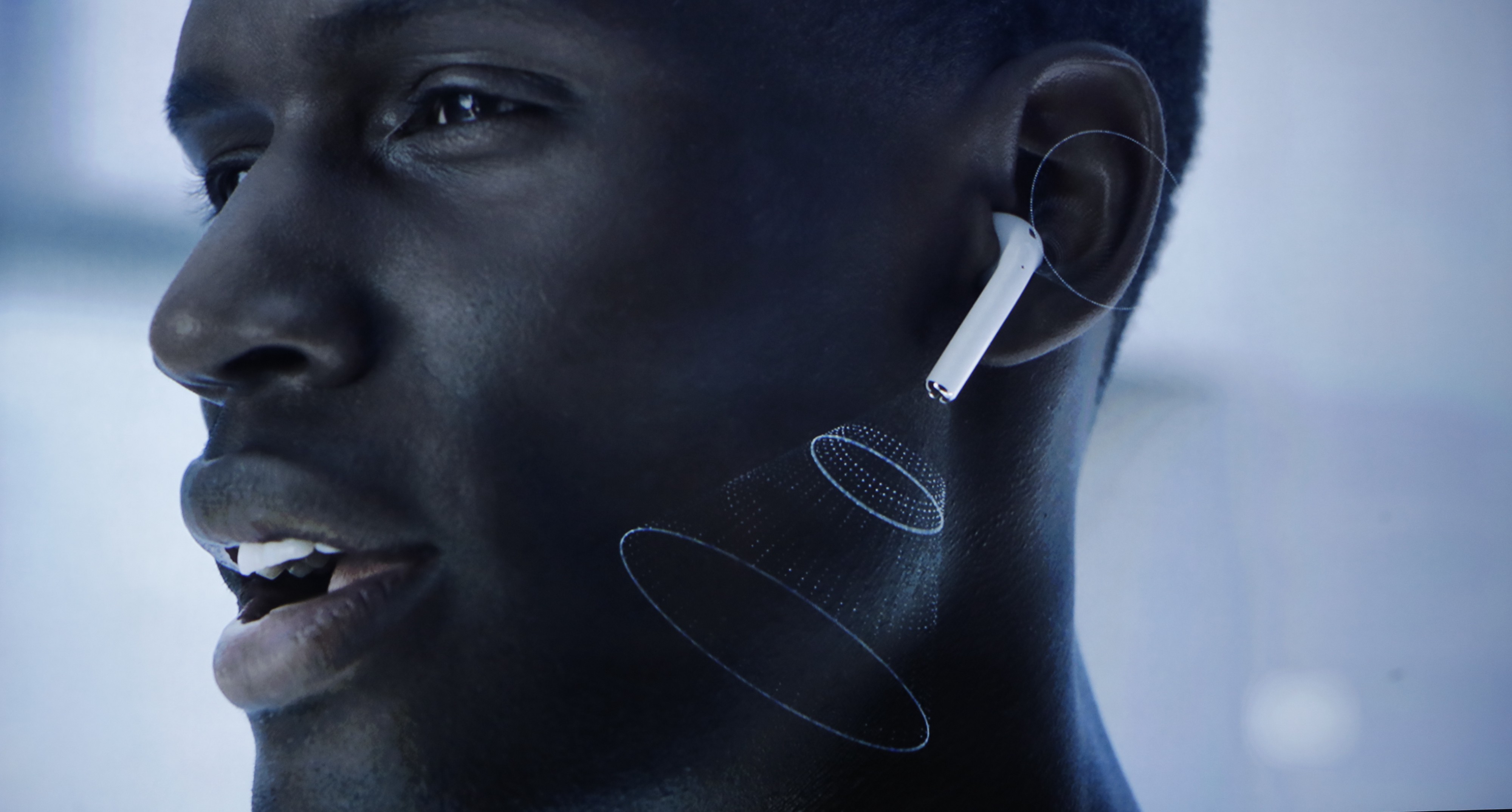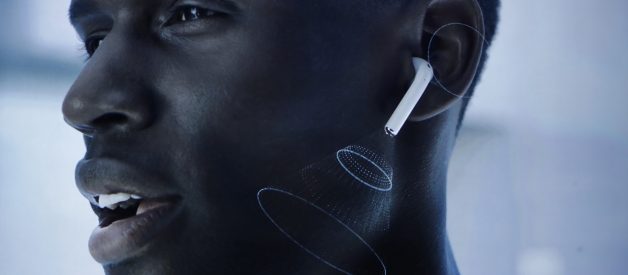Listen to this story
–:–
–:–
Microprocessing
It?s all about the fit and the background noise
 Photo: Stephen Lam/Getty
Photo: Stephen Lam/Getty
In Microprocessing, columnist Angela Lashbrook aims to improve your relationship with technology every week. Microprocessing goes deep on the little things that define your online life today, to give you a better tomorrow.
AirPods are everywhere ? even though they?re pretty awful at what they do.
This style of earbud, which rests next to your ear canal but not quite inside it, offers practically zero noise isolation. In other words, AirPods, by far the most popular wireless earbuds, do a poor job overpowering noise like chattering colleagues or teens on the subway. The natural response is to turn the volume louder to compensate ? which can quickly turn dangerous for your hearing.
?I?m seeing a lot of younger people in their twenties who are coming in with ringing in their ears,? says Sarah Mowry, an assistant professor of otolaryngology at Case Western Reserve University School of Medicine. ?I think it?s probably related to this all-day earbud use. It?s noise trauma.?
Headphones, in and of themselves, are not a risk. You could listen all day at a low-to-middle volume without health worries. It?s only once you start listening to loud volumes for sustained periods of time that they can start damaging your ears.
It?s likely that earbuds are contributing to widespread hearing damage among younger people.
And the type of headphones that are the most likely to cause hearing problems are these earbuds. A 2007 study found that adults turn up their music louder when they?re wearing earbuds than over-the-ear headphones. It also discovered that users wearing earbuds were more likely to turn up their volume to compensate for background noise (in this case, street noise and ?multi-talker babble?) than people wearing over-the-ear headphones. A further study, from 2011, expanded on that research, finding that teens wearing earbuds turn their volume up to overcome background noise, some to harmful levels, more than those wearing noise-isolating, over-the-ear headphones.
Brian Fligor, an audiologist who has studied the impact of earbuds on hearing damage, says that people typically listen to their earbuds about 13 decibels higher than the background noise. If you?re wearing headphones or earbuds in a school classroom, where the background noise usually runs at about 60 decibels, and you turn your music up to 73 decibels to compensate, that should be fine for most people?s ears. But if you?re in a noisy coffee shop, where background noise is usually about 70 decibels, or on an airplane, where the noise typically reaches 80 decibels, things get dicey. ?When the background noise induces [people] to listen 13 decibels louder than the background and the background is 70 decibels, now we?re talking about potential to do damage,? he says.
Public transportation is ?the number one time and place for you to be exposed,? says Fligor. The New York City subway system is monumentally loud: the mean noise level on subway platforms and inside the trains is 94 decibels, and 20 percent of those spaces exceed 100. Add 13 decibels from turning up your earbuds, and we?re at anywhere from 107 to 113 decibels, yet people can only safely be exposed to 100-plus decibels for 15 minutes a day.
You can see the problem.
This may help explain why my hearing has gotten so terrible in recent years. My Bay Area bus commute, which was typically at least an hour long and at least 84 decibels twice a day, five times a week, was bad enough. Now I live in New York, where for several years I commuted about an hour one way on the train, and where public transportation is quite a bit louder. (I work from home now, bless.) That was at least 10 hours a week I spent exposing myself to unhealthy levels of noise ? and most of the time, I was wearing my Apple earbuds.
So is most everyone else. 2014 research, conducted by Fligor and others, looked at the impact of urban environments on people?s headphone listening levels by measuring sound levels through a mannequin?s ears. The research involved asking passersby to take their headphones off and place them on this mannequin at the same volume level they had been listening to. The average listening level was 94 decibels, 58 percent of people polled were exceeding their weekly sound exposure limit ? and an overwhelming 92 percent of them were wearing AirPod-style earbuds. (The researchers excluded canalphones, those earbuds that go deep into your ears, from their survey, because the mannequin used to test volume didn?t have deep enough ears to accommodate them.)
?In quiet, only a very small percentage of people choose levels that are potentially hazardous,? says Cory Portnuff, an audiologist at the University of Colorado Hearing Research Lab. The addition of background noise, though, makes for ?a totally different story,? according to Portnuff.
It?s likely that earbuds are contributing to widespread hearing damage among younger people. According to the American Osteopathic Association, approximately one in five teens today suffer some form of hearing damage, a rate that?s 30 percent higher than it was 20 years ago. The World Health Organization estimates that over ?1 billion young people? are at risk of hearing loss, primarily from listening to music on headphones or earbuds.
Adults, meanwhile, have experienced a leveling out in hearing loss ? but societal factors indicate that that rate should have gone down, not stayed the same. ?We?ve outsourced a lot of our manufacturing jobs and that?s where a lot of noise-induced hearing loss was coming from,? Fligor says. Disregarding hearing loss among those serving in the military, which is on the increase, people are generally much healthier than they were in past decades, and therefore, ?our rate of hearing loss should be going down, and we know that it?s not,? says Fligor.
You can listen to 80 percent of your headphones? maximum volume for 90 minutes before you start damaging your hearing.
While there?s some research to suggest that listening to music may not be as detrimental as we think, Portnuff and Fligor both agree that it can cause damage. The question is how long it?ll take for that damage to set in, and how the hazard posed by headphones and earbuds intersects with other, daily sounds like traffic, construction, and crowds.
While there?s only so much we can do about loud workplaces and bustling bars, we can mitigate the potential damage from listening to headphones or earbuds. For the safest volume levels, Portnuff recommends ?80 for 90? meaning you can listen to 80 percent of the maximum volume for 90 minutes before you start damaging your hearing.
And you should think about ditching the AirPods for quality over-the-ear ? and preferably noise-cancelling ? headphones, or snug-fitting, in-ear canalphones. If you like the convenience of AirPods, which quickly and seamlessly pair with your iPhone, try BeatsX or the new Powerbeats Pro, both of which contain the same proprietary Apple chips used by AirPods.
?I prefer a style that physically blocks background noise by sealing your ear rather than a style with digital noise-cancellation systems,? Portnuff says. The Wirecutter recommends the over-the-ear, closed-back Sony H900N, which combines physical sound isolation with active noise isolation that allows you to keep your music on a lower level, even on an airplane or crowded subway. They?re $300, which isn?t cheap, but that?s only $100 more than the latest model of AirPods ? and considerably less likely to be dropped down a subway grate.
For a cheaper option, the tech review site RTings recommends the Mpow H10, which at $66 are nearly $100 less than a pair of AirPods. If you want something that looks nice, Mashable suggests the Urbanears Plattan 2, which have pretty good passive noise-isolation, come in lots of colors, and have a wireless option. They range from $50 to $100, depending on whether you can handle a cord. And if you prefer an in-ear headphone style, CNET says the $250 Bose QuietComfort 20 are comfortable with excellent noise-cancelling capabilities.
?It?s a whole lot cheaper to protect your hearing than it is to try to remediate your hearing,? says Fligor. ?Hearing is outrageously precious. People take it for granted, they lose it, and then you can?t get it back.?
I don?t need another reminder because my hearing is bad enough as it is. Cute, pink noise-isolating headphones: add to cart.


